#vampire books
Text
As your Goth Auntie is apparently in the grips of Goth Nostalgia ...
Three books that were good examples of the mood of 90s goth:
Actually written in the 90s: Lost Souls by Poppy Z. Brite. Content warning: if you're someone who is uncomfortable with taboo themes in fiction, give this a pass.
Not written in the 90s, but set then and captures the mood: In the Blood by Miranda Luna. It certainly has writing flaws, but definitely hits the Goth Nostalgia button for me.
Also not written in the 90s, but damn, all of us wanted the goth club in this book to exist. Gothique by Kyle Marffin. The writing is clunky in places (and has one plotline too many, IMO), but it's still a nostalgia rush.
All three of them are, yes, vampire novels, and I would put content warnings on all three for people who want to avoid taboo themes or unhealthy relationships. (If you are one of those folks, I suggest avoiding vampire fiction altogether, but that's a different discussion.)
353 notes
·
View notes
Text

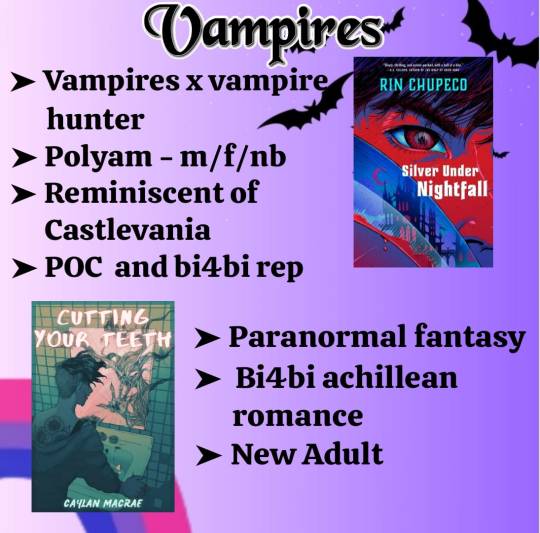


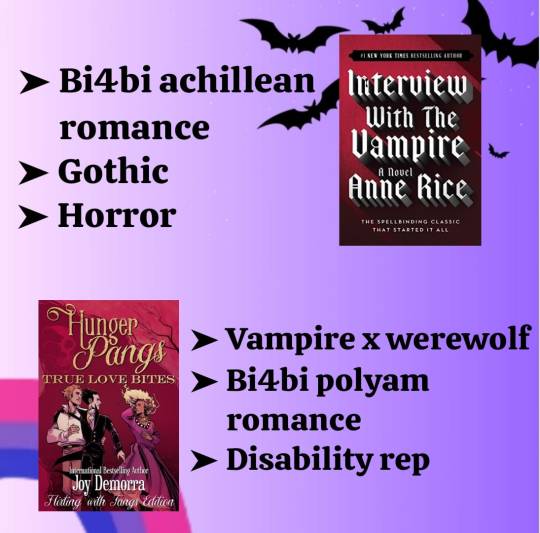




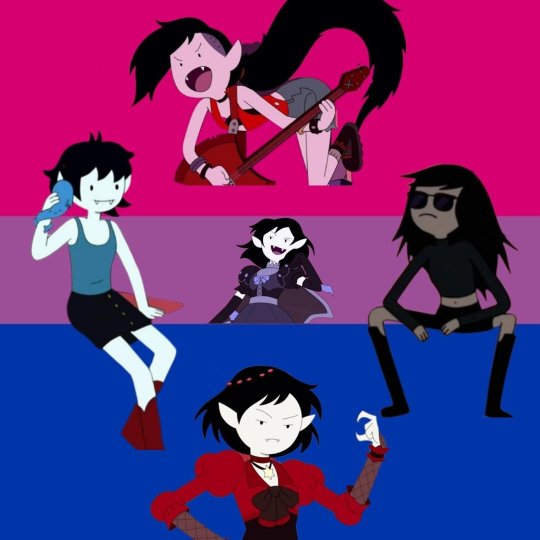
Happy October! Here are bisexual books with vampire and werewolf MCs that I found! (do let me know of more books like these if you know)
And I included Marceline because how can I not? She is our iconic canon bisexual and black vampire queen!!
Books listed:
💖Vampires
Silver Under Nightfall by Rin Chupeco
The Lost Girls by Sonia Hartl
Cutting Your Teeth by Caylan MacRae
A Flame in the Night by Morgan Dante
The Modern Mythos Anomaly by Juniper Lake Fitzgerald
A Dowry of Blood by S.T. Gibson
Interview with the Vampire by Anne Rice
True Love Bites by Joy Demorra
💖Werewolves
Wolfsong by T.J. Klune
Edge of the Woods by Jules Kelley
Teeth and Tarot by A.A. Fairview
Mate of Her Own by Elena Abbott
Kinship and Kindness by Kara Jorgensen
Undaunted by Devin Harnois
💖Honorable mention - Werebear
Bearly A Lady by Cassandra Khaw
#bisexual#bisexual representation#bisexual pride#bi books#bisexual books#sapphic books#achillean books#booklr#book blog#wlw books#mlm books#queer books#lgbt books#lgbtq books#bisexual romance#bookblr#book tumblr#Bi rep#vampire books#werewolf books#My posts
531 notes
·
View notes
Text
Vampire fang boners are actually one of my favorite tropes. “His fangs lengthened”??!???! Hell yeah they did, bite me with your horny fangs you bitch
#vampires#the black dagger brotherhood#jr ward#j. r. ward#black dagger brotherhood#books#vampire books#book tropes#vampire tropes
506 notes
·
View notes
Text

#twilight#vampire#vampires#vampirecore#vampyr#gothic#vampire girl#goth#vampire aesthetic#vampire goth#vampirism#vampyre#vampire books#vampire bite#vampire art#vamplove#vampire fiction#horror
4K notes
·
View notes
Text

Thrilled to share this artwork I created for the endpapers of a new German edition of Vampire Academy! This series holds such a nostalgic place in my heart and I still love my bad ass girl Rose. 😊
#vampire academy#dimitri belikov#bloodlines#frostbite#shadow kiss#spirit bound#last sacrifice#vampire books#YA books#rose was on of the first bad ass lady MC’s I ever read and she will always be iconic for that#rose hathaway
485 notes
·
View notes
Text
How To Write Vampires With An Original Twist
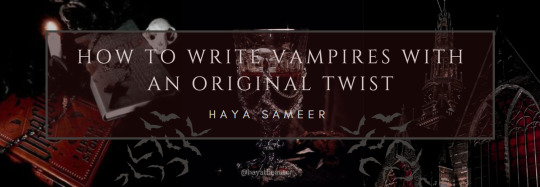
Mythical creatures are an essential part of the fictional scene, but the same creatures have been used so many times that these creatures now often seem redundant and boring in fiction. This is why I've started a new blog series: How To Create Original Mythical Creatures. I'm kicking off this series with vampires!
Join me as we dive into the world of vampires, from their mythical beginnings to their modern-day interpretations, and learn how to write them effectively in your own narratives.
Origins of Vampires
Vampires have a rich and diverse history rooted in ancient folklore and legends. Across various cultures and civilizations, tales of bloodsucking creatures have emerged, each with unique characteristics and behaviors.
One of the earliest known vampire myths comes from ancient Mesopotamia, where stories of blood-drinking demons known as Lilitu or Lamashtu date back to around 3000 BCE. These entities were believed to prey on humans, particularly targeting children and pregnant women.
In ancient Greece, the Lamia was a mythical creature often depicted as a female vampire who lured and devoured children. Similarly, in Roman mythology, the Strix or Strigoi were vampiric entities that fed on blood and flesh.
Moving forward in history, Slavic folklore introduced the concept of the Upyr, a vampire-like creature that rose from the dead to feed on the living. These early depictions of vampires often portrayed them as revenants or undead beings with a thirst for human blood.
Modern-Day Vampires: Where Were They Originated?
The modern concept of vampires, as we commonly know them today, took shape during the European Middle Ages and the Renaissance. Legends of vampires emerged in Eastern Europe, with notable figures like Vlad the Impaler contributing to the folklore. Vlad's reputation for cruelty and his association with impaling enemies on stakes led to the creation of the vampire archetype, inspiring Bram Stoker's iconic character, Count Dracula.
From ancient Mesopotamia to medieval Europe, vampire lore has evolved and adapted, weaving its way into popular culture and literature. Understanding the origins of vampires provides writers with a rich tapestry of mythology to draw upon when crafting their own bloodsucking creatures.
I wanted to go into more detail regarding the Lamashtu and Lamia since they’re not as well known as their Slavic and European counterparts, but unfortunately, that would deviate from the purpose of this blog.
The Evolution Of Vampiric Appearances
Before we proceed with this section, it's crucial to clarify that the mythical creatures and beings discussed in this blog are not direct representations of ancient vampires. Instead, they serve as inspirations for the concept of vampires and share certain attributes with our modern-day depictions, including blood-feeding, pale skin, human-like appearance with some animalistic features, and so on.
Vampiric Creatures In Mythology
In ancient mythology, vampiric entities were not always depicted as the suave, charming figures we see in modern vampire tales. Instead, they often embodied primal fears and monstrous traits.
Lamia: In Greek mythology, Lamia was a terrifying creature depicted as a woman with a serpentine lower body. She was known for her insatiable hunger for children, often depicted as a child-eating monster. Lamia's appearance combined elements of human and serpent, emphasizing her monstrous nature and predatory instincts.
Lamashtu: In Mesopotamian mythology, Lamashtu was a malevolent demon who preyed on pregnant women and newborns. She was depicted with a fearsome appearance, often described as having the head of a lion, the body of a donkey, and bird-like talons. Lamashtu's grotesque features and destructive tendencies reflected ancient beliefs about the dangers of childbirth and infancy.
Lilitu: In Mesopotamian and Jewish folklore, Lilitu or Lilith was often associated with nocturnal demons or spirits. She was depicted as a seductive, winged demoness who preyed on men and newborns. Lilitu's appearance varied across different myths but often included features like wings, long hair, and sometimes talons, emphasizing her otherworldly and dangerous nature.
Strix: In Roman and Greek mythology, the Strix was a bird-like creature or vampiric owl associated with dark omens and death. It was believed to be a shape-shifting creature that could transform into a woman or an owl. The Strix's appearance combined avian and human features, instilling fear and dread in those who encountered it.
Strigoi and Upyr: In Eastern European folklore, Strigoi and Upyr were blood-sucking undead creatures similar to modern-day vampires. Strigoi were believed to be restless spirits or revenants that returned from the dead to torment the living. Upyr, on the other hand, were vampire-like beings with sharp fangs and a penchant for drinking blood. Both creatures were depicted as pale, gaunt, and often with elongated canines, reflecting their predatory and undead nature.
Medieval Depictions: Shift in Appearance
During medieval times, the depiction of blood-sucking mythological creatures underwent a transformation, shifting from monstrous and terrifying to more humanoid and relatable appearances. This change in portrayal can be seen in various aspects of their physical features:
Teeth: Originally depicted with long, sharp fangs or talons for blood-drinking, medieval depictions often featured more subtle fang-like teeth or no visible teeth at all, aligning with the concept of vampires being able to blend in with humans.
Skin: While ancient vampires were often described as monstrous and otherworldly, medieval vampires were portrayed with paler skin to signify their undead nature but without extreme deformities or monstrous features.
Appearance: Medieval vampires were often depicted as more human-like in appearance, with regular clothing and a less monstrous demeanour. This shift allowed for more nuanced storytelling and exploration of themes like temptation, desire, and the struggle between humanity and monstrosity. This is also what birthed the romanticization of vampires.
Mythological Vampire vs Modern-Day Vampire
Mythological vampires, rooted in ancient folklore and mythology, were often depicted as malevolent spirits or creatures with supernatural powers. These creatures varied widely across different cultures, from the Lamia and Lilitu in Mesopotamian mythology to the Strix in Roman and Greek folklore, and the Upyr in Slavic tales.
These ancient vampires were not always the suave, charismatic beings we see in modern media. Instead, they were often portrayed as terrifying and monstrous, with features that reflected their otherworldly nature. For example, the Lamia was described as a demonic woman with the ability to transform into a serpent, while the Lilitu were associated with storm demons and fertility spirits.
In contrast, modern-day vampires, especially those popularized in literature and film, have undergone significant transformation. They are often depicted as sophisticated and alluring, with a penchant for romance and drama. Authors and filmmakers have humanized vampires, giving them complex personalities, tragic backstories, and even moral dilemmas.
While modern vampires still retain some traditional attributes such as a need for blood and sensitivity to sunlight, their portrayal has evolved to include a wide range of characteristics and abilities. This shift has allowed for more diverse and nuanced storytelling, exploring themes of immortality, love, redemption, and the eternal struggle between good and evil.
Which Option Is Better For Your Novel?
When deciding which type of vampire to incorporate into your story, consider the tone and themes you wish to explore. Mythological vampires offer a darker and more primal essence, rooted in ancient fears and superstitions. On the other hand, modern-day vampires provide a canvas for exploring human emotions, relationships, and societal issues through a supernatural lens.
Ultimately, the choice between mythological and modern vampires depends on the narrative direction and atmosphere you want to create. Both types offer unique storytelling opportunities, allowing you to craft captivating tales of mystery, romance, horror, or even philosophical introspection.
Research and Resources
Writing about mythical creatures like vampires requires a solid understanding of folklore, mythology, and literary traditions. Here are some resources and research methods to help you delve into the world of vampires and other mythical beings:
Books and Literature
Start by exploring classic works of literature that feature vampires, such as Bram Stoker's "Dracula," Anne Rice's "The Vampire Chronicles," and Stephenie Meyer's "Twilight" series. These novels not only showcase different interpretations of vampires but also delve into the cultural and historical contexts surrounding these creatures.
Mythology and Folklore
Dive into ancient myths and folklore from various cultures to uncover the origins of vampire legends. Look into Mesopotamian, Greek, Roman, Slavic, and other mythologies to discover different vampire-like entities and their characteristics.
Research Journals and Articles
Academic journals and articles can provide valuable insights into the evolution of vampire folklore, the psychological aspects of vampirism, and the cultural impact of vampire mythology. Explore journals in folklore studies, literary analysis, and cultural anthropology for in-depth information.
Online Resources
Utilize online platforms such as mythology databases, folklore websites, and literary forums to gather information and engage in discussions about vampires. Websites like The Vampire Library, Vampire Empire, and Vampire Rave offer a wealth of resources for vampire enthusiasts and writers.
Historical Research
Delve into historical records, archival documents, and historical accounts related to vampire hysteria, vampire burials, and vampire folklore in different regions. Understanding the historical context can add authenticity to your portrayal of vampires.
Interviews and Expert Opinions
Consider reaching out to folklore experts, historians, and scholars specializing in vampire mythology for interviews or consultations. Their insights and expertise can provide valuable perspectives on vampire lore and storytelling.
Creative Exploration
Don't hesitate to let your imagination roam while exploring vampire mythology. Experiment with creating your own vampire mythology, incorporating unique traits, powers, and origin stories for your vampires.
By combining thorough research with creative exploration, you can develop rich and compelling portrayals of vampires in your writing. Remember to stay open to diverse interpretations and adaptations of vampire folklore, allowing room for innovation and originality in your storytelling.
I hope this blog on How To Write Vampires With An Original Twist will help you in your writing journey. Be sure to comment any tips of your own to help your fellow authors prosper, and follow my blog for new blog updates every Monday and Thursday.
Looking For More Writing Tips And Tricks?
Are you an author looking for writing tips and tricks to better your manuscript? Or do you want to learn about how to get a literary agent, get published and properly market your book? Consider checking out the rest of Haya’s book blog where I post writing and publishing tips for authors every Monday and Thursday! And don’t forget to head over to my TikTok and Instagram profiles @hayatheauthor to learn more about my WIP and writing journey!
#hayatheauthor#writing community#haya sameer#haya's book blog#writing tools#writing advice#writer things#writer community#haya blogs#writers on tumblr#writing life#writing techniques#writing stuff#writer tools#writers of tumblr#writer blog#women writers#writer stuff#writer advice#writer tips#creative writing#novel writing#writing vampires#vampire#vampire books#writerblr#writing corner#writing inspo#ya writing advice#writing tips and tricks
122 notes
·
View notes
Text
Queer horror from my teens

I periodically wonder whether these books are still known and read by young goths and horror fans as they were all extremely important to me in my teenage years, so I thought I'd share them.
Though I'm cishet, during the mid 90s two of my favourite authors wrote primarily queer fiction: they were Anne Rice and another author from New Orleans who is now known as Billy Martin.
He came out as a trans man in 2011, however these books were published prior to that so unfortunately you have to search for them under his deadname. This is why I've used that name in the tags on this post. I don't believe the books were ever reprinted with his current name.
Though I loved Rice, I always felt a more immediate connection with Martin due to his vivid portrayal of subcultures like goth and punk, and how it felt to be a teenager who was part of them. I could see myself in many of his characters as I had the same interests, listened to the same music, and shared the same sense of social alienation. Remember in the 90s the Internet was still a reasonably new thing, and many of us didn't have a home Internet connection at all. There was certainly no social media, no YouTube, and no real way to meet and interact with like-minded teens unless you were lucky enough to have another "weird kid" at your school. If you were a weird kid, you likely had very few friends and were bullied.
That as much as anything else led me to seek solace in books written by an author who I felt understood me, and characters who became my friends.
Lost Souls is about vampires in a kind of Lost Boys/Near Dark way. Fans of the YouTuber OfHerbsAndAltars might be interested to know that this book is where the name of his channel comes from - it's a description of the taste of Chartreuse liqueur.
Drawing Blood is about ghosts, a "murder house", computer hacking, comic art and a very beautiful (if rather messed up) romance. This one is probably my favourite of the three.
Exquisite Corpse is about serial killers, set against the AIDS crisis of the 90s. If you like the Hannibal TV series you'll probably enjoy this one - imagine if Dennis Nilsen and Jeffrey Dahmer had somehow met.
Martin doesn't pull any punches when it comes to descriptions of blood and gore, violence, abusive parents or his portrayal of toxic romantic relationships (of which there are many in his books), but if you can deal with those things there is also a great deal of beauty, phenomenally good writing, and a somewhat unique perspective on the supernatural.
Maybe I'm biased, looking at these through the lens of my teenage self. Maybe they'd seem horribly dated to today's young audience. But I still wanted to make this post in case there's someone out there who will end up loving them as much as I did.
#queer horror#lgbt horror#90s goth#90s punk#90s alternative#goth#gothic#horror#vampire books#vampire fiction#haunted house#poppy z brite#billy martin#lost souls#drawing blood#exquisite corpse#of herbs and altars#90s#trans author#queer author#goth book#gothic horror#goth subculture#punk subculture#lgbt fiction#queer fiction#queer goth#Lgbt goth
94 notes
·
View notes
Text



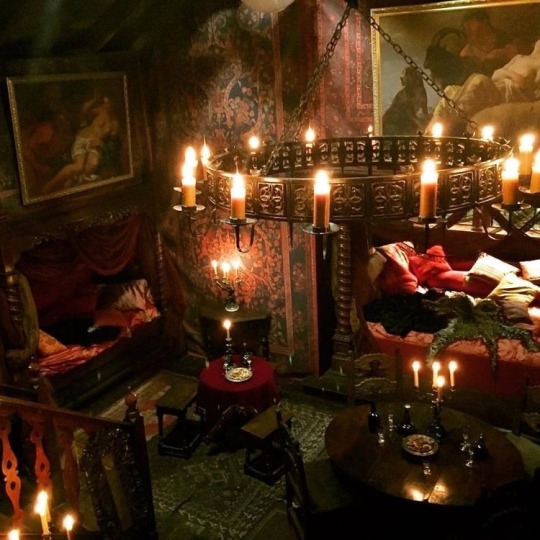
Not a want … a need
#vampirism#vampire aesthetic#goth#gothic#vampire goth#queen of the damned#what we do in the shadows#taika waititi#vampire books#vampirecore#vampcore#vampire
466 notes
·
View notes
Photo

Rosalie Hale
#twilight#twilight fandom#twilight rosalie#rosalie hale#rosalie cullen#alice cullen#vampire aesthetic#vampire moodboard#rosalie hale mood#twilight moodboards#twilight moodboard#lana del ray#Vampire movies#vampire books#green aesthetic#twilight eclipse#Twilight Breaking Dawn#Twilight New Moon#twilight aesthetic#Pinterest#dark green#teemataulu#jasper cullen#emmet cullen#edward cullen#Bella Swan#carlise cullen#renesmee cullen#vampire
266 notes
·
View notes
Text

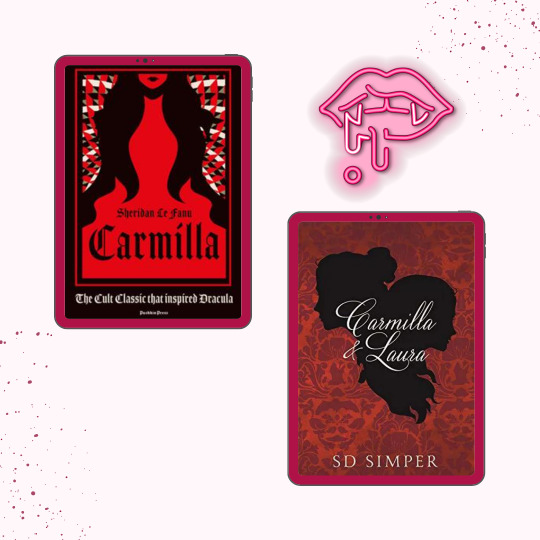




🦇 Good afternoon, my beautiful bookish bats! How was your Halloween? What did you dress up as?
🐈⬛ We didn't get a single trick-or-treater, so I'm a tiny bit disappointed. Anyway, I prepared WAY too much content for October. We have two black cats and I love bats; every day is spooky season here! To keep the spooky vibes going, here are a few queer vamps to consider reading about before the end of the year!
❤️ Carmilla by J. Sheridan Le Fanu
🦇 Carmilla & Laura by SD Simper
🩸 The Lost Girls by Sonia Hartl
❤️ Youngblood by Sasha Laurens
🦇 Court of the Undying Seasons by A.M. Strickland
🩸 The Fell of Dark by Caleb Roehrig
❤️ Terrible Praise by Lara Hayes
🦇 The Coldest Touch by Isabel Sterling
🩸 Dowry of Blood by S. T. Gibson
❤️ A Flame in the Night by Morgan Dante
#books#queer fiction#queer romance#vampire#vampire books#queer vampire#queer community#queer books#queer#read queer all year#books to read#sapphic books#sapphic romance#batty about books#battyaboutbooks#spooky#spooky season#halloween#book blog#booklr
109 notes
·
View notes
Text

The Vampire Bookcase in its new home. Remember, embrace your cliches. Embrace them so hard they squeak.
(And as always, almost every shelf is double-stacked.)
213 notes
·
View notes
Text


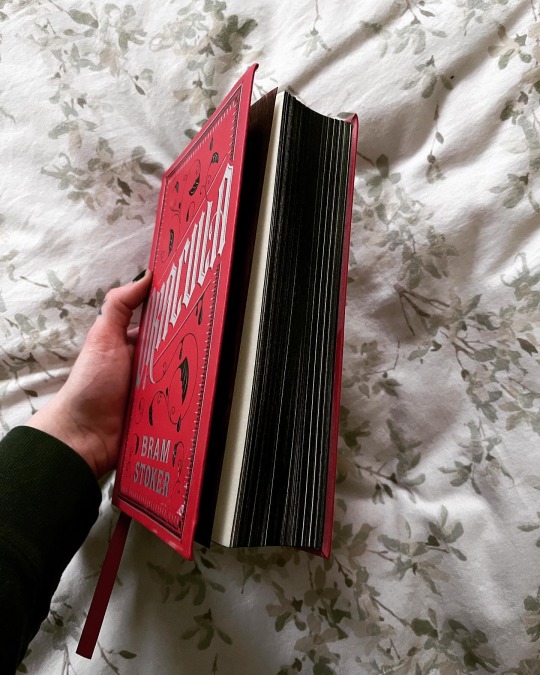
What’s your favorite ✨Classic✨ ?
#godzilla reads#classic literature#classic lit#dracula#bram stoker#classic books#vampire books#booklr#bookworm#bookish#book blog
234 notes
·
View notes
Text
"You piss me off so much that I would fill your mouth with my blood until you choke."
- Just a love language between two enemies in Wattpad story
#wattpad#wattpadstories#wattpad recommendations#enemies to lovers#vampire#vampire aesthetic#romance books#vampire books#dark romance#dark romanticism#romance#goth aesthetic#gothicstyle#gothic#goth girl#love quotes#horror#horror stories#dark souls#darkness#dark poetry#dark fantasy#fiction#fanfiction#vampire diaries
59 notes
·
View notes
Text

#vampire#vampires#vampirecore#vampyr#gothic#goth#vampire girl#vampire aesthetic#vampire goth#vampirism#vampyre#vampire books#vampire bite#vamplove#vampire art#meme
1K notes
·
View notes
Text
When the girl dinner™️ did not consist of the blood of my morally-questionable lover/enemy and therefore upsets my stummy:

#castlevania#castlevania netflix#castlevania show#castlevania video game#castlevania symphony of the night#castlevania sotn#castlevania alucard#alucard#dracula#castlevania nocturne#adrien tepes#dracula tepes#vampire#vampires#vampirecore#vampire aesthetic#vampire show#vampire books#vampire games#castlevania memes#vampire memes#castlevania sypha#castlevania Trevor#Trevor Belmont#girl dinner
110 notes
·
View notes
Text
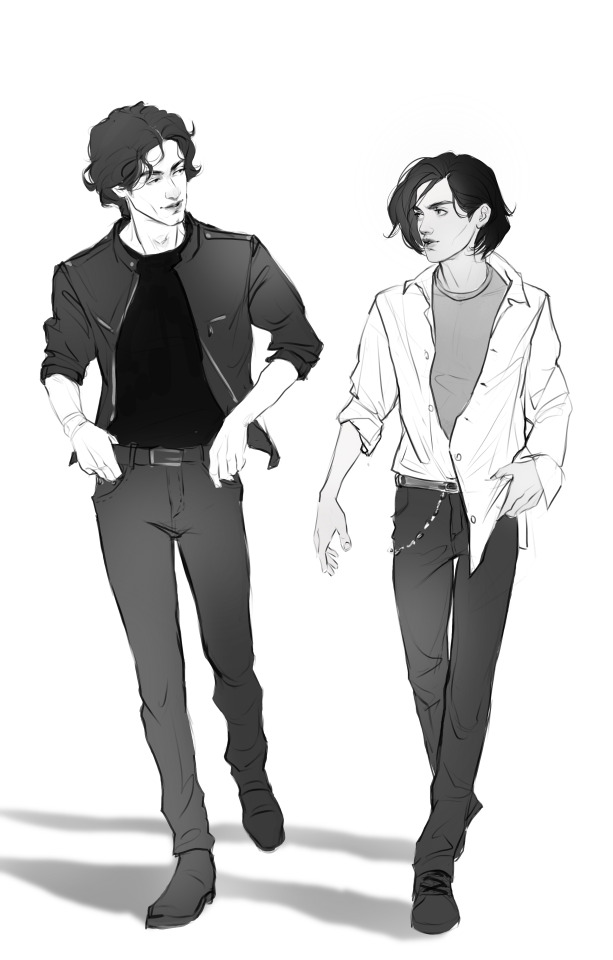
Maddox and Diego from the Stars and the Stage, drawn by @thistlearts
Guess what's coming out NEXT WEEK?!
(Hint: it's the new prequel novella for the Guides for Dating Vampires series, the Stars and the Stage!)
While we're waiting for the third main series book, I'm so excited to bring you this wonderful, fierce second chance couple who comes back together like a thousand fireworks after ten years apart. For a little sneak peak at who they are as a couple, check out this snippet from the first chapter that shows a bit of their teenage relationship before their breakup…
Once Diego's safety had been his arms, clutching them close when they lost a lead role in drama club or holding them back when the nastier kids had insulted them for their heritage—as though many of their ancestors hadn’t lived in California longer than any of these preppy white families—with whispers that this wasn’t the time, that vengeance would be sweeter if it couldn’t be traced back to them. He had been the safe haven who’d helped them paint everything from dicks on the expensive leather of those bullies’ sports cars to the elaborate stage sets that only he and Diego truly appreciated.
His were the screams that had echoed their own across the school halls and the hands that had pressed them against the lockers with every ravaging kiss, the only person who avidly agreed with them that the highs and lows of their teenage love was a thing the whole world had to play audience to.
He had been the boy who never tried to tame their fire, but always managed to stoke it in a better direction.
Then he’d torn that protection down in one terrible night.
(For one more week, you can still pre-order the ebook for only 99 cents!)
#my writing#queer books#trans representation#vampire books#gay vampires#writeblr#booklr#gay romance books
67 notes
·
View notes